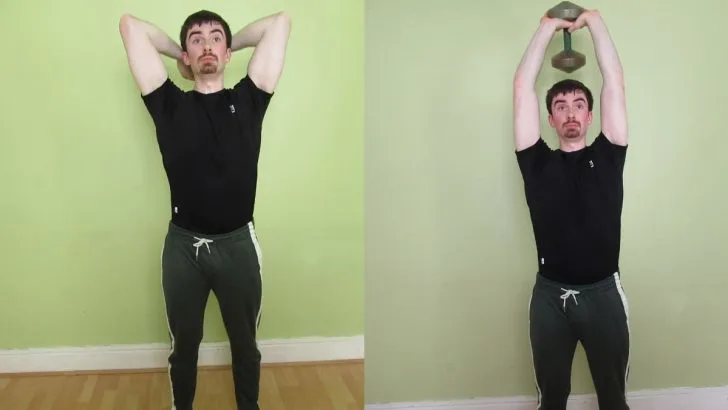The standing dumbbell overhead tricep extension is a highly effective mass-building movement for developing all three heads of the triceps. Unlike other exercises, however, the standing overhead dumbbell tricep extension emphasizes the biggest of these three heads—the long head—which means that it’s naturally capable of packing on plenty of upper arm size.
This detailed guide demonstrates 8 overhead extension variations that you can do to train your triceps. So regardless of your equipment availability and gym membership status, you’ll still be able to achieve an excellent workout.
After that, we’ll expose 5 common overhead triceps extension mistakes that could be sabotaging both your gains and your joints.
Then, we’ll explore the muscle-building benefits of overhead extensions, which you can look forward to if you perform the exercise correctly and on a regular basis. Finally, we’ll finish with an in-depth overhead DB tricep extension FAQ.
Standing dumbbell overhead tricep extension exercise details
- Also Known As: Tricep curl, OH tricep extension, standing triceps press
- Main Muscles: Triceps
- Exercise Type: Strength
- Exercise Mechanics: Isolation
- Difficulty Level: Beginner
- Equipment Needed: Dumbbell
How to do dumbbell overhead tricep extensions
- Cup both hands around one end of a dumbbell, and then press the weight over your head.
- Bend your elbows to lower the dumbbell behind your head.
- Descend until you feel an intense stretch in your triceps (most likely when your forearms and biceps make firm contact).
- Reverse the motion by flexing your triceps until your elbows reach complete extension.
- Perform 3-5 sets of 8-20 reps.
Overhead tricep extension variations
In addition to the dumbbell overhead extension demonstrated above, there are another 7 OH extension variations that you can train your triceps with. Let’s explore the pros and cons of each version to see which exercise(s) is best for you.
Overhead DB tricep extension (two dumbbells)
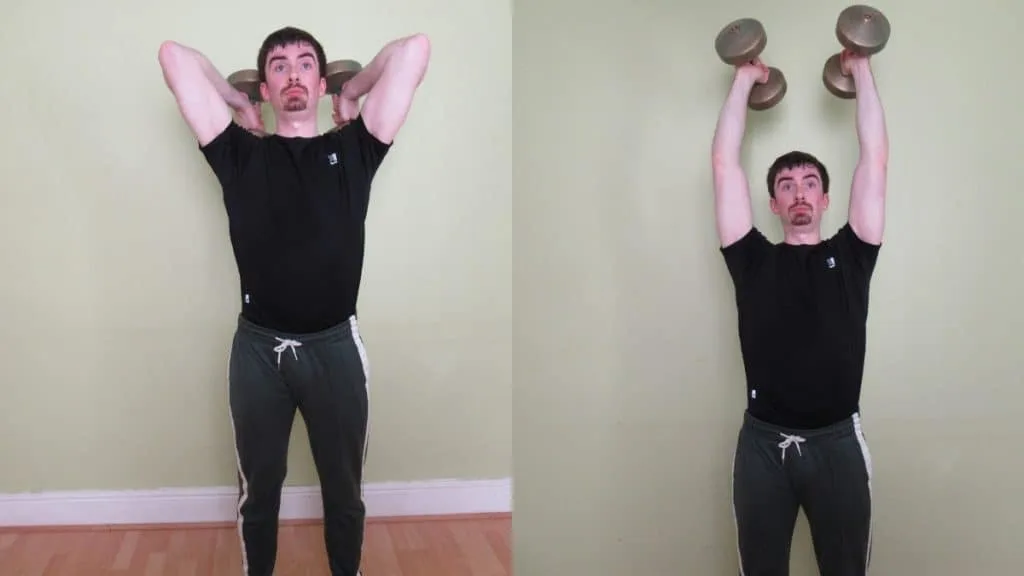
The regular DB overhead extension, where you have both hands cupped around the same dumbbell, is an undeniably effective muscle-building exercise.
But because your stronger triceps muscle is able to dominate the movement by lifting a higher percentage of the dumbbell’s mass, the standard DB overhead tricep extension isn’t the best exercise for developing muscle symmetry.
Lifting one dumbbell per arm is the simple fix.
Yes, this will mean lifting less total weight. But remember, your triceps can’t read the number on the side of the dumbbell, nor can they calculate how many reps you’re performing. In fact, as a piece of meat, your triceps brachii only responds to tension, so don’t fret about using less resistance.
Training both arms independently with separate dumbbells lets you ensure that both of your triceps are receiving similar amounts of work and thus growing more or less in proportion.
This balanced growth, in turn, leads to enhanced upper arm symmetry and a more aesthetic physique, which is particularly important if you’re a bodybuilder.
Another good exercise in this respect is lying DB extensions. Although they require a bench, lying extensions are typically less taxing on your rotator cuffs than overhead extensions, which is ideal if the overhead tricep extension hurts your shoulder.
Barbell overhead extensions
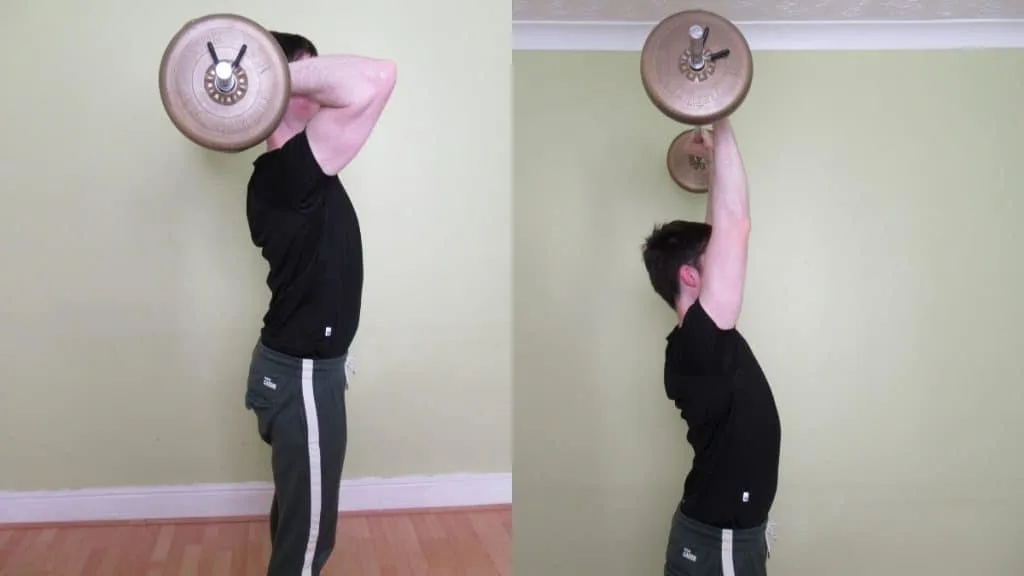
The overhead barbell extension is one of the most popular types of tricep curls because it enables you to overload your triceps with even more resistance than the two arm dumbbell extension.
Since the triceps is a fast-twitch muscle, it responds exceptionally well to heavy, low rep training, which is where barbells really flex their muscles.
Sticking with moderate reps, however, is the best bet for most lifters because performing tricep curls with dumbbells and barbells can put a lot of stress on your elbow joints.
Unlike the dumbbell version, the barbell OH tricep extension is superior for gaining strength because you can increase the weight in smaller increments, especially if you have access to fractional plates.
All else being equal, lifting heavier weights will lead to more triceps growth.
The drawback of using a barbell for the tricep extensions exercise is that it can lead to muscular imbalances and wrist pain. While the first issue is an unavoidable side-effect of barbell training in general (though you can minimize it by using good form), you can fix the latter problem by doing an overhead tricep press with a curved bar.
EZ bar standing tricep extension
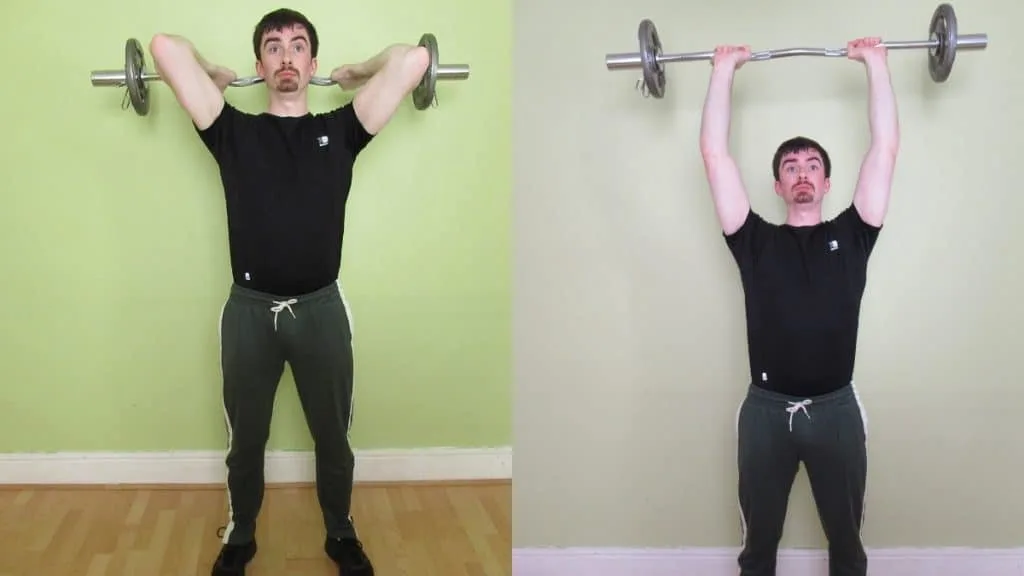
The EZ bar overhead tricep extension comes with all the benefits of the straight bar version—high overloading potential, excellent microloadability, a growth-stimulating eccentric triceps stretch—but without the wrist pain problem.
Unlike straight bars, easy curl bars have semi-pronated grips. These handles are naturally much more comfortable to hold than those of an Olympic bar, especially if you’re pushing heavy poundages because they don’t force your wrists into unnatural amounts of pronation.
Having the ability to focus on training the target muscles rather than being forced to fight the discomfort in your wrists will help you to establish a stronger mind-muscle connection with your triceps and thus stimulate more robust hypertrophy.
The only downside of using a curved bar is that their weights can vary between gyms. So if you train in different fitness facilities, then you might end up using bars of different weights. This disparity could throw off your strength progression and make you think that you’re getting weaker or stronger when, in fact, it’s just because the bar is heavier or lighter.
The way around this issue (for most people) is to use a fixed EZ bar that specifies its weight on the side. Of course, these bars might not be heavy enough if you have titanic triceps, and besides, they’re not ideal for microloading the resistance in small increments.
Cable tricep overhead extension
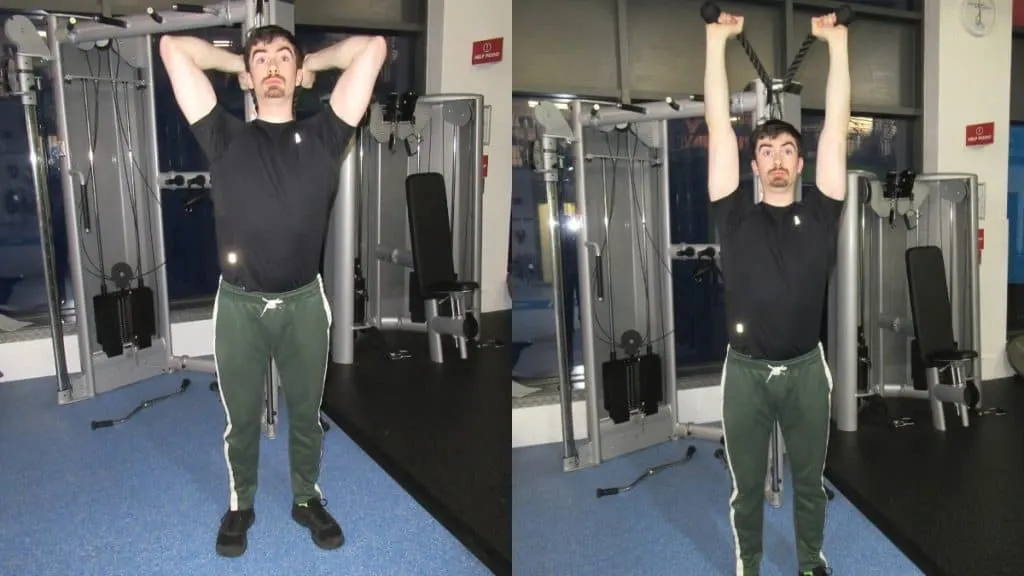
If you want to blast your triceps with constant tension and joint-friendly resistance, then the overhead cable extension is the best exercise for you.
Cables require less stabilization than free weights because the wires are wrapped around a pulley mechanism, meaning that they naturally put less torque through your joints. This reduced stability requirement makes cable tricep raises easier to learn for beginners than overhead DB extensions.
Yet, the exercise is equally useful for advanced lifters because you can train your triceps with cable extensions after your stabilizer muscles are fatigued from heavy free-weight training.
Performing this arm extension exercise with cables also opens up a whole new world of workout variety because you can use various attachments to train your triceps differently. A rope attachment, for example, enables you to spread each end of the rope and generate a stronger tricep peak contraction than you could otherwise achieve by using a bar attachment.
As mentioned, cables also challenge your triceps with constant tension, which makes them particularly suited to high rep metabolite training. This is because your muscles can’t rest at any point during a cable O H tricep extension rep since, once the weights come off the stack, the pulley is constantly exerting some kind of force on your triceps.
One arm DB tricep extension
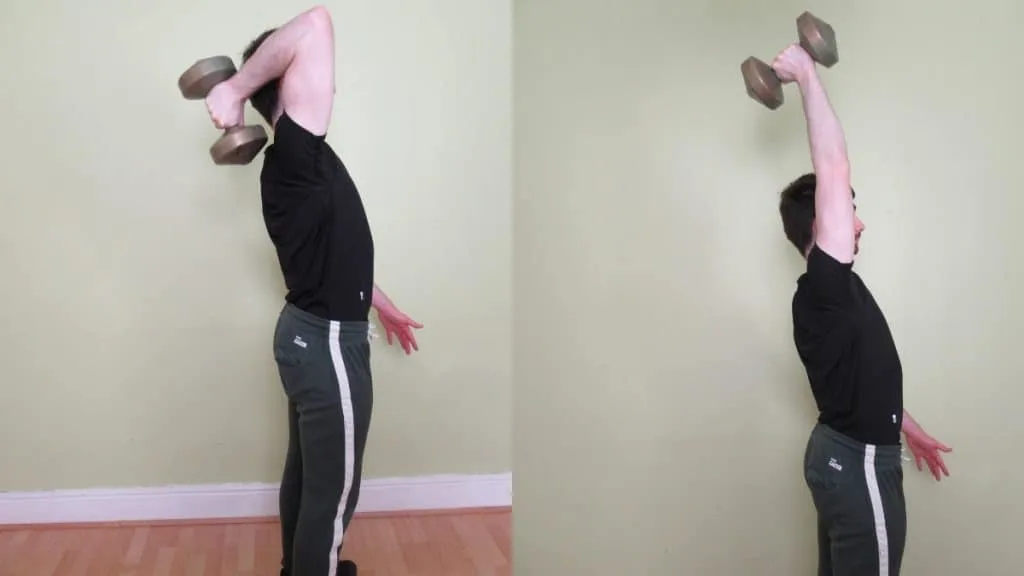
If you want to sculpt maximum triceps symmetry and fix your muscular imbalances, then the one arm overhead extension is the most effective exercise for the job.
Performing standing tricep extensions one arm at a time means that you don’t have to split your focus over two limbs. Although moving two arms simultaneously isn’t exactly complicated, it’s still much easier for your brain to move one arm at a time.
As such, you can establish a stronger triceps mind-muscle connection by performing the standing dumbbell extension in a unilateral fashion because you can dedicate all of your strength and focus to training the target muscles—not on coordinating limb movements.
Similarly, it’s easier to prevent your elbows from flaring out excessively when you only have to focus on lifting one weight.
The only drawback of the unilateral overhead tricep press is that your workout will take longer to get through because now you’re doing a set for each arm.
You can also do a seated one arm overhead dumbbell extension so that your core muscles don’t have to work as hard, which may help you to better isolate your triceps.
Seated dumbbell overhead extension
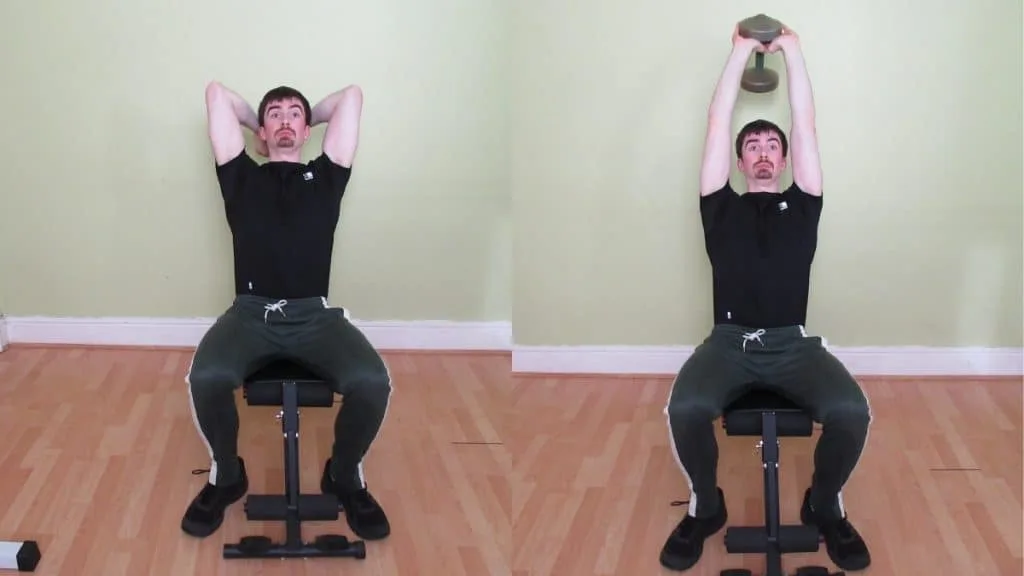
The seated overhead tricep extension has a lower core stability requirement than the dumbbell standing triceps extension because your back is braced against the bench.
This means that you can focus purely on training your triceps, which may help you to maintain the proper form and get a better pump.
The trade-off, especially from a fat-loss perspective, is that seated exercises like the overhead dumbbell tricep press burn fewer calories and lead to less abdominal activation than their standing equivalents. [1]
If you’re performing the dumbbell tricep overhead extension later in your workout, when your core will naturally be more fatigued, then it makes sense to do the seated version so that you don’t work your abs at the expense of your triceps.
Of course, if you’re training at home without a bench, then you’ll want to stick with the standing dumbbell triceps extension because it requires nothing more than a single dumbbell.
Reverse grip overhead triceps extension
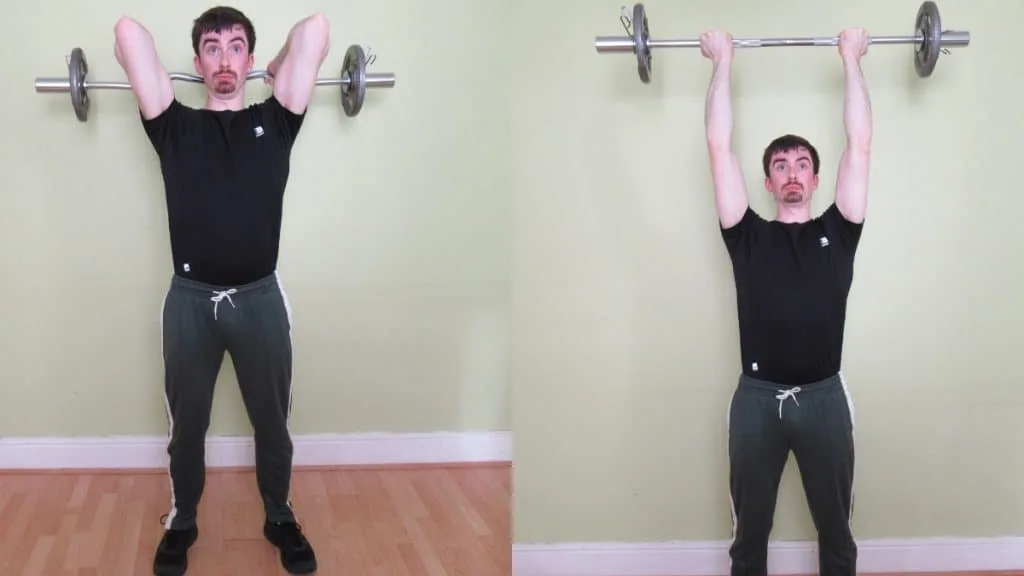
You can do reverse grip overhead triceps extensions with cables, bars, and bands.
The theory behind using a reverse grip is that it prevents your elbows from flaring out, which, as you’ll soon learn, is a mistake that lifters commonly make during standing triceps presses.
While using a reverse grip certainly encourages you to keep your elbows tucked in, it doesn’t force you to tuck them because the triceps, as elbow extensors, aren’t affected by your hand position in any way.
In other words, with just a small amount of effort, you can rotate your wrists without moving your elbows at all. Hence why using a reverse grip for a two arms triceps extension makes little sense—it just makes it harder to hold the bar.
Overhead dumbbell tricep extension mistakes
Tricep overhead extensions are a safe and effective exercise when you use the proper form. But if you make any of these common technique mistakes, then you could be putting your muscle growth and joint health at risk.
Performing partial reps
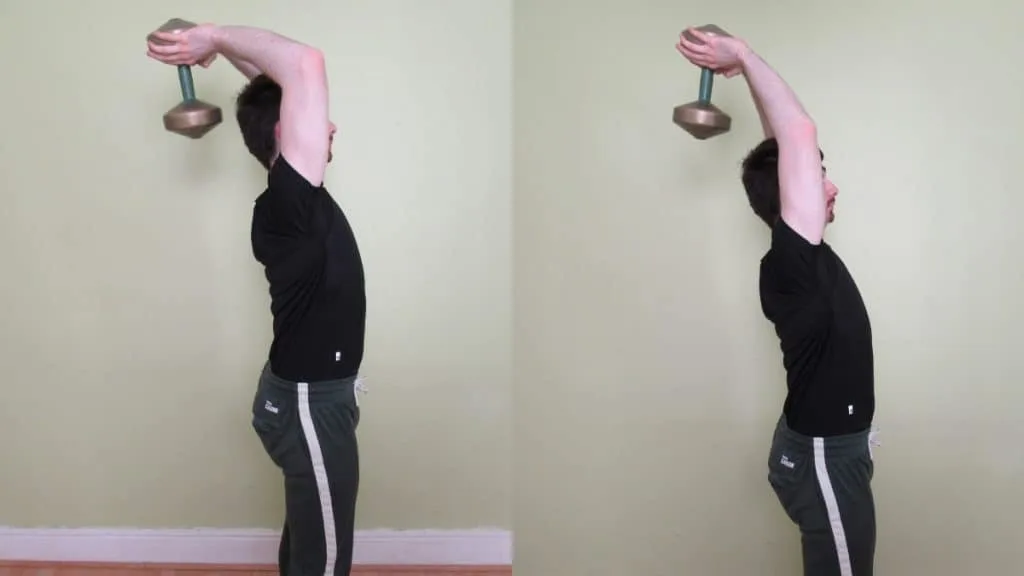
Performing partial reps is a bad idea for two main reasons.
First off, doing half rep standing dumbbell tricep extensions (by failing to lower the weight deep enough) significantly shortens the crucial eccentric stretch. This mistake means that fewer muscle fibers get recruited, which ultimately leads to a far less potent hypertrophic stimulus for your triceps.
Second, performing partial overhead dumbbell tricep extensions encourages you to lift heavier weights than you can handle over a full range of motion.
So while it might look like you’re getting stronger by doing half reps, your triceps won’t gain strength because, if anything, they actually receive less tension when you do partials.
Worse still, lifting too heavy means that your joints get subjected to more stress, which can lead to pain, injury, and—bodybuilders cover your eyes—time off the gym as a result.
Lowering the weight too quickly
Lowering the dumbbell too quickly during the DB triceps extension is a mistake that has two major consequences.
Failing to control the descent robs your triceps of tension because gravity rather than your triceps is responsible for the weight moving down when you just let it drop.
As if that wasn’t bad enough, performing hurried eccentrics places significantly more stress on your elbows because your joints are forced to absorb the torque that your triceps would usually handle during clean reps.
Coupled with this error is the common mistake of “bouncing” out of the bottom of the rep. While using the stretch reflex is recommended for other exercises like squats, bouncing your forearms off your biceps during the overhead dumbbell tricep extension is a bad idea because it can hurt your elbows.
If bouncing or using momentum is something that you struggle with, then pause for a second at the bottom of the rep before lifting the weight back up. This technique forces your triceps to do all of the lifting, which is the one and only purpose of an isolation exercise like the overhead dumbbell extension.
Using momentum to ego lift
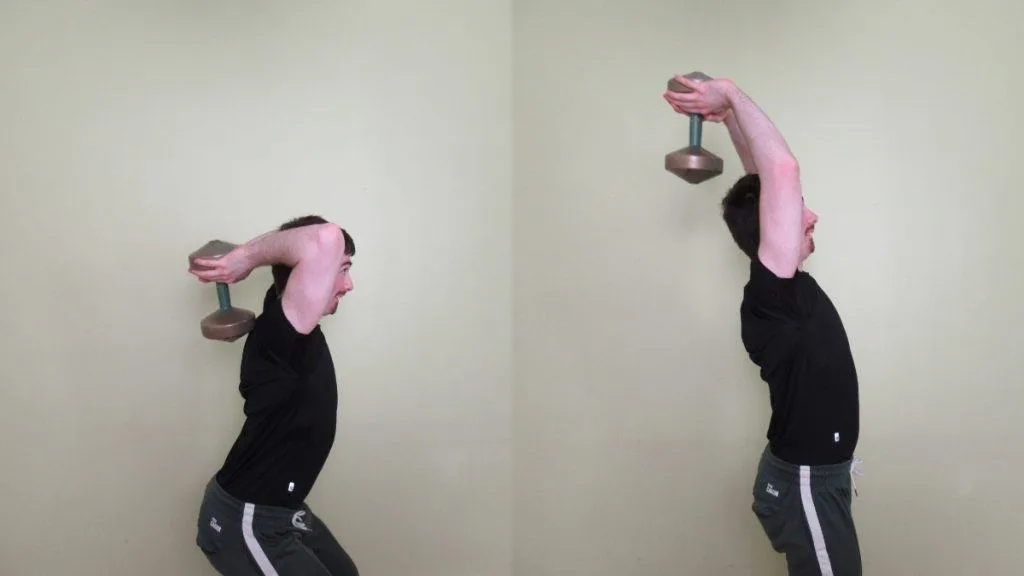
Momentum is the enemy of isolation exercises, and, like a certain bad influence himself, it comes in many insidious forms.
What might begin as a bit of body English on your final few reps could morph into full-blown swinging and jerking that effectively transforms your tricep extension into a full-body movement.
Needless to say, using inertia to lift the weight places less tension on your triceps (even if you’re using a heavier dumbbell) because the extra resistance is being distributed across more muscle groups. In reality, your triceps should be the only muscle lifting the dumbbell.
This cheating often takes the form of knee bending and shoulder pressing. But you can eliminate it by “locking it down,” which is to say by keeping your abs, glutes, and quads tight.
Thinking of dumbbell overhead tricep extensions as a single-joint exercise can help to ensure that you don’t bring other muscles into the movement. Once the weight is over your head, only your elbow joints should flex and extend, as if they were a highly specialized machine manufacturing crucial equipment (in this case, a muscular pair of triceps!). [2]
Allowing forward elbow movement
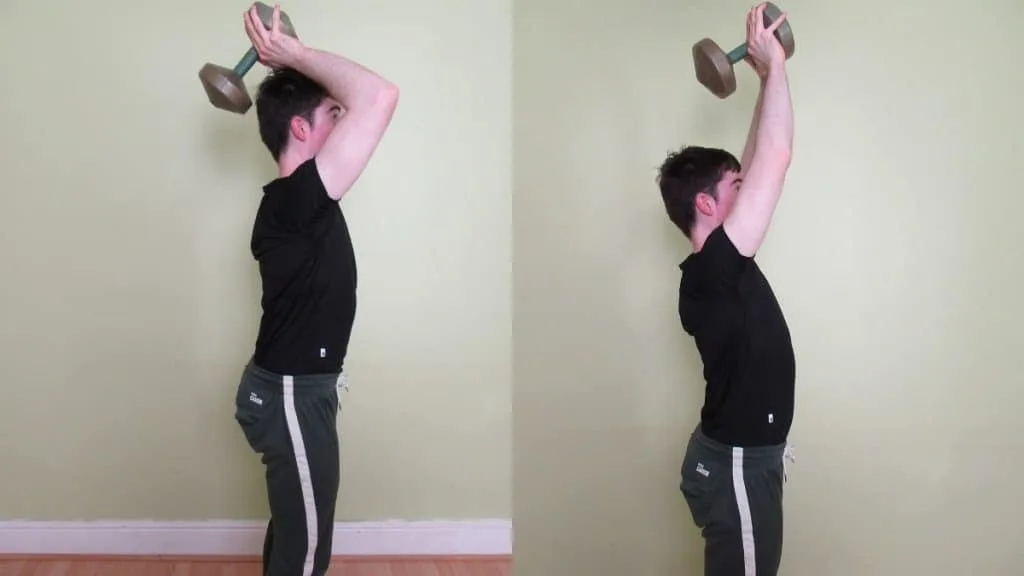
Letting your elbows drift forward turns the overhead dumbbell extension into a weird kind of behind the neck tricep press.
In other words, failing to keep your elbows completely parallel with the ground turns this tricep isolation exercise into a compound shoulder press.
Many lifters have a tendency to let their anterior deltoids assist their triceps during the concentric phase of the rep, which usually happens for one of two reasons.
First off, some people simply lack the shoulder mobility to get their arms all the way behind their head. If this is the case for you, then you should seek to improve your mobility because reaching back with the weight places the long head of the triceps under a remarkable eccentric stretch. [3]
Second, people tend to let their elbows come forward when they get fatigued. But as mentioned, all this does is change the exercise from a single-joint extension to a multiple-muscle press.
So in order to gauge how much work your triceps are doing—the whole point of measuring isolation exercise performance—put your arms well behind your head and then lock your elbows in place until the set is over. As you’ll see for yourself, this enhanced technique strictness makes the dumbbell overhead extension far more challenging for your triceps.
Using the wrong grip
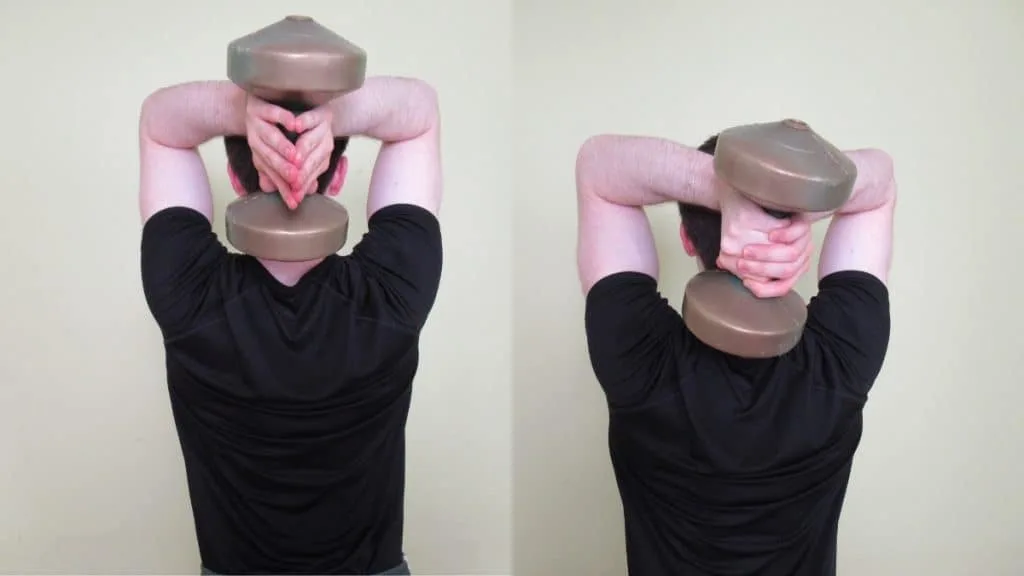
Thus far, all of the mistakes have applied to tricep overhead extensions in general. The following error, however, is primarily applicable to barbell versions of the exercise because it revolves around grip width.
You can, of course, make a similar mistake during the overhead DB tricep extension by forcing yourself to use a grip that you don’t find comfortable just because everyone else seems to hold the dumbbell in a certain way.
There’s no right or wrong way to grip the dumbbell during the DB overhead extension. You can cup your hands around one end of the weight, or you can use an open grip and press the handle between your palms. Try both and see which you prefer.
As far as barbells go, it’s a similar story; there’s no such thing as universally optimal tricep extension grip.
In general, though, those with smaller frames and narrow shoulders will likely find a closer grip to be more comfortable (which is to say easier on the shoulders). Conversely, those with large builds and broad shoulders will typically find a wider grip to be more comfortable.
One thing that you want to avoid altogether, however, is extreme grip widths. A close grip doesn’t mean that you should do tricep extension exercises with your hands touching. Nor does a wide grip mean holding the very ends of the barbell.
The advantage of overhead dumbbell extensions in this regard is that they take the guesswork out of finding the most comfortable grip. This is simply because you’ll be holding the dumbbells with a neutral grip if you’re using two weights, in which case you can only alter the degree of elbow flare, not your grip width.
Benefits of overhead dumbbell extensions
The standing tricep extension is one of the most popular upper arm exercises of all time, and for good reason. Here are the benefits of the overhead triceps extension exercise that you can enjoy when you work out consistently and with the proper form.
More pressing strength
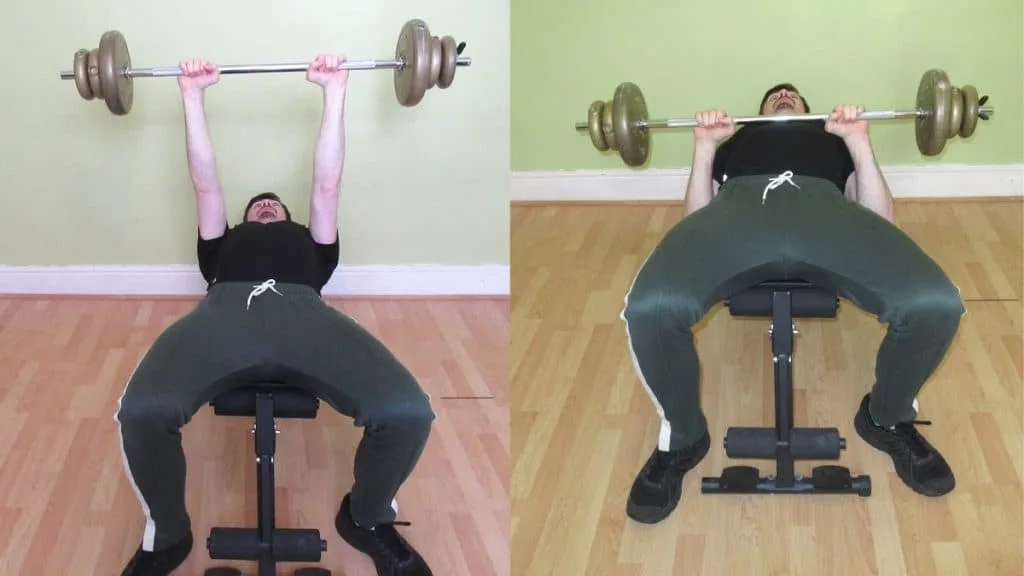
Bench pressing big numbers requires strong triceps to lock out the weight.
Sure, your pecs and front delts do a lot of work during the initial phase of the rep. But once the bar is clear of your chest, it’s down to your triceps to perform their primary function—elbow extension—in order to lock out the weight.
Performing a behind the head tricep extension is an excellent way to build a bigger bench because you’re effectively doing heavy lockouts with nothing but your triceps.
This extra triceps strength will help you to set new bench press and overhead press PRs because you’ll be able to lock out the weight with more conviction and power.
So if you’re a powerlifter, an Olympic weightlifter, or if you’re simply the kind of gym-goer that loves lifting heavy, then it’s well worth isolating your triceps with the dumbbell arm extension. All else being equal, a bigger pair of triceps muscles is a stronger pair of triceps muscles.
Complete triceps development
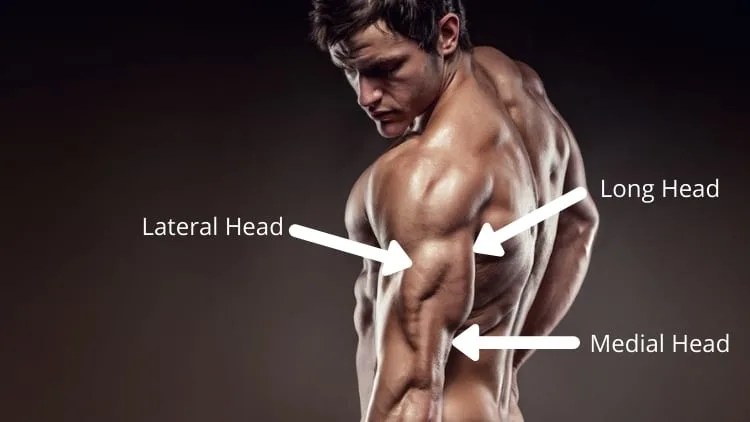
Performing the overhead tricep extension dumbbell style hits all three heads of the triceps—lateral, medial, and long—and thus leads to balanced upper arm development.
Yet, because the dumbbell triceps extension puts your shoulders in a high degree of flexion, it’s an especially effective exercise for training the long head, which is the largest of the three tricep heads. [4]
Since only the long head crosses the shoulder joint, extending your arms behind your head naturally forces the long head to do more of the lifting, which means that it also gets a greater share of the muscle-building tension.
Specifically, doing an overhead tricep extension with dumbbells and the like creates an intense eccentric muscle stretch because the weight is always trying to pull you backward. As such, it’s down to the long head of your triceps to handle the tension as you lower the dumbbell behind your head.
Big upper arms
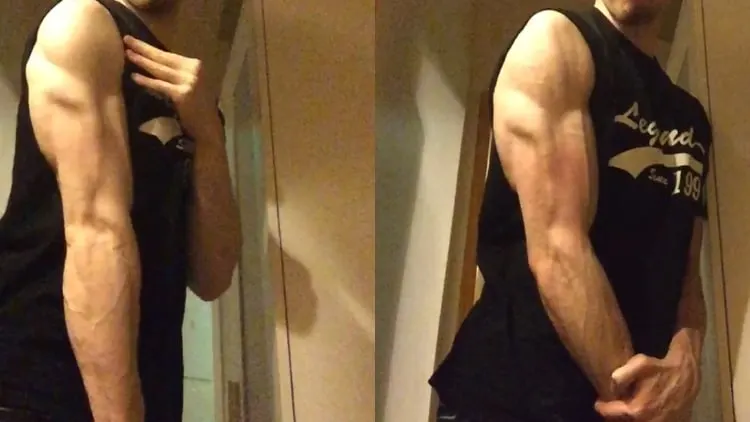
Extra long head activation is great. But what does this actually mean for the size of your arms?
Quite a lot, actually. Since the long head is bigger than the lateral and medial heads combined, it makes up the bulk of your triceps mass.
And considering that the triceps account for two-thirds of your total upper arm size (or, at least, they have the potential to if you do equal amounts of extensions and curls), the long head becomes the single most crucial arm muscle for gaining mass.
So if you want to build your arms and fill your sleeves, DB tricep extensions, which feel a bit like doing tricep pushdowns with dumbbells, are just about the best size-building exercise that you can perform.
Increased core strength
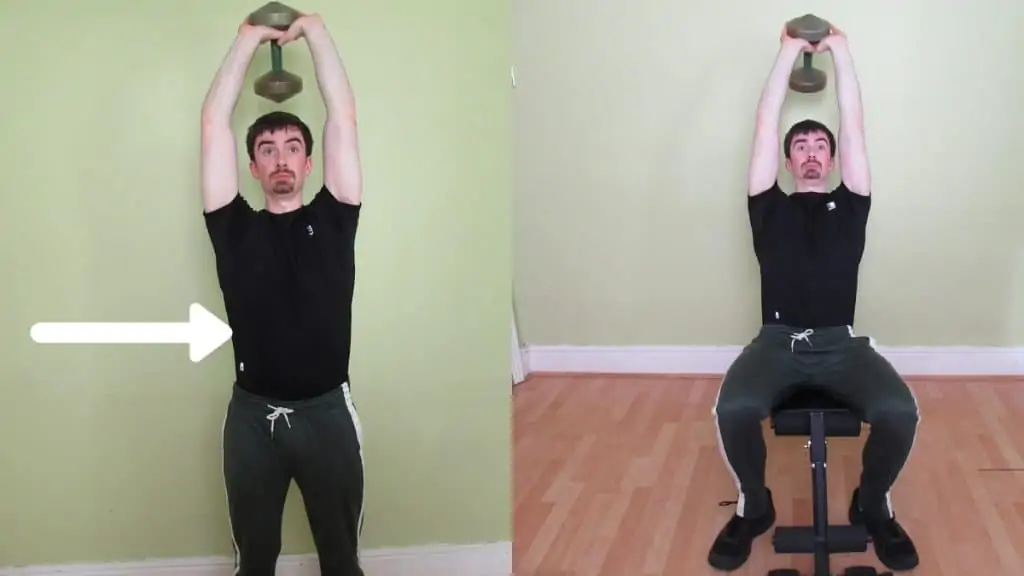
Many bodybuilders do the overhead tricep dumbbell extension sitting down so that they don’t have to put as much effort into stabilizing their core (the theory behind this being that sitting down will better enable them to focus on isolating their triceps).
While this may well be the case, the difference in triceps activation between seated and standing positions isn’t huge, especially if you already have a solid mind-muscle connection.
Compared to a seated extension, performing a standing two arm tricep extension (and, to a lesser extent, a kneeling triceps extension) burns far more calories and forces your abs to contract much harder.
So if you want to work multiple muscles simultaneously and burn more calories in the process, then definitely do dumbbell overhead extensions in a standing position.
Standing up is also better for your lower back because your legs will take more of the strain. And besides, you won’t need to wait around for a bench to become available.
Overhead dumbbell extension training recommendations
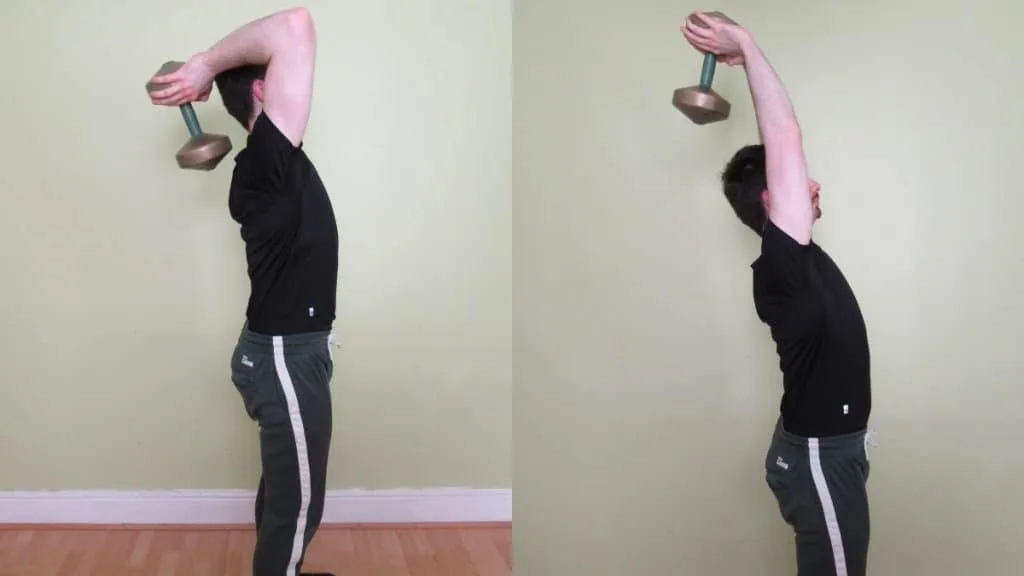
You should do between 8-20 tricep extension reps on each set. Yes, that’s a broad rep range; let me explain why.
Muscles, as mere pieces of meat, don’t understand what reps, pounds, or kilos are. Your triceps just respond to the tension that you put them under.
Knowing this, it’s possible to achieve excellent gains by training your tris with any number of reps. The catch is that you need to train close enough to muscular failure so that the muscle fibers actually get recruited.
You also need to account for the fact that low rep training, while undeniably effective for both strength and mass gain, can oftentimes be brutal for the elbows of many lifters.
In a similar vein, performing in excess of 15 reps or so on each set can leave your entire body exhausted, which decreases the quality of work that you can perform on subsequent sets, which ultimately reduces the hypertrophic stimulus for your triceps.
For these reasons, the standing overhead tricep extension is best performed for moderate reps in the 8-12 rep range. Do between 3-6 sets per session, bearing in mind that for optimal triceps development, you’ll want to include a mixture of other movements in your routine.
As for exercise frequency, you shouldn’t do overhead extensions more than twice per week due to the high amount of torque that extensions put through your elbow joints. You can, of course, train your triceps more frequently than twice weekly, but you should mix in more joint-friendly exercises like pushdowns and kickbacks to make the volume tolerable.
Standing dumbbell tricep extension FAQ
We covered both basic and advanced questions in this handy OH tricep extension FAQ.
What is an overhead dumbbell tricep extension?
An overhead dumbbell tricep extension, also called an overhead tricep press, is an isolation exercise that weight lifters, bodybuilders, and athletes perform in order to strengthen their triceps muscles.
The exercise is done by holding a weight behind the head and then lowering it to stretch the triceps. The trainee then reverses the motion by flexing their triceps until their elbows reach full extension.
Although typically done with dumbbells for convenience, overhead extensions, like the lying tricep extension, can be performed with a variety of other equipment such as bands, bars, and kettlebells.
Common mistakes include failing to control the descent, using momentum to lift the weight, and performing partial reps. These errors are generally thought to put the trainee at greater injury risk and reduce the hypertrophic stimulus for the triceps brachii.
What muscles do dumbbell overhead tricep extensions work?
The primary muscles worked during dumbbell overhead tricep extensions are the lateral, medial, and long head of the triceps brachii, which is the large three-headed muscle located on the back of the upper arm.
Since overhead triceps extensions place the shoulders in a high degree of flexion, the exercise gives extra emphasis to the tricep head that crosses the shoulder joint—the long head. Thus, it is the long head that performs the majority of the work during a dumbbell overhead triceps extension.
Since the long head accounts for most of the triceps mass, the standing dumbbell extension is popular among those seeking to maximize muscle hypertrophy.
Are overhead triceps extensions safe?
If you understand how to do tricep extensions correctly, then the exercise is generally safe.
While most people can perform the movement pain-free when they use the proper tricep extension form, overhead extensions can still cause elbow pain for some lifters.
A common reason for this discomfort is that people often lower the dumbbells too far down, which puts too much of a stretch on their elbow joints.
On the other hand, some people simply have poor connective tissue health and can’t perform dumbbell overhead extensions without feeling discomfort in their elbows.
Lifting lighter weights for higher reps can often reduce or eliminate elbow pain because lower resistance levels put less torque through the joints, tendons, and ligaments of the elbow.
If you have elbow pain from tricep extensions, then make sure to talk to a physical therapist so that you can receive a proper diagnosis for your particular problem.
You can also see our tricep extension alternative guide if you want to research exercises that don’t put as much stress on your elbows.
What other equipment can you use for a standing triceps extension?
If you don’t have access to barbells or dumbbells, then you can do a plate tricep extension instead.
This variation has the benefit of encouraging you to keep your elbows tucked in because you have to hold the weight plate with a neutral grip.
You can also perform a kettlebell tricep extension if you find kettlebells easier to hold than dumbbells.
On the other hand, if you’re working out at home, then the resistance band tricep extension is likely your best bet because you can perform it just about anywhere.
Additionally, there are exercises like the tricep extension lunge, which you can do to achieve a combined upper and lower body workout, a combination that’s great for maximizing calorie burn.
Conclusion: Who should do the overhead tricep extension?

If you want to make your triceps stronger and/or more muscular, then the standing overhead tricep extension is an excellent exercise for the job and one which requires nothing other than a dumbbell.
Dumbbell overhead tricep extensions work all three heads of the triceps while giving extra emphasis to the long head, which, as noted previously, has the most growth potential of the three tricep heads.
Additionally, performing the dumbbell overhead triceps extension in a standing position gives your core a tremendous isometric workout because your abs have to contract in order to keep your torso straight.
You’ll also burn more calories when you do the overhead DB tricep extension standing, which is ideal if you’re in a cutting phase or trying to lose body fat.
References
- Silver, N. (2021, June 1). Do You Really Burn More Calories While Standing? Healthline. https://www.healthline.com/health/fitness-exercise/calories-burned-standing
- Jones, O. (2019, January 22). The Elbow Joint – Structure – Movement. TeachMeAnatomy. https://teachmeanatomy.info/upper-limb/joints/elbow-joint/
- Ilano, J. M. (2021, October 11). 6 Shoulder Stretches To Ease Pain And Improve Mobility. GMB Fitness. https://gmb.io/shoulder-mobility/
- AnatomyZone. (2021, February 28). Triceps Brachii Muscle – Origin, Insertion, Action, 3D Model. https://anatomyzone.com/upper-limb/upper-arm/triceps-brachii-muscle/

